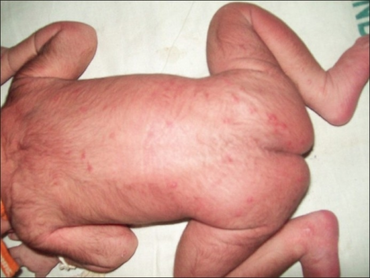Congenital cutaneous candidiasis
| Congenital cutaneous candidiasis | |
|---|---|
| Other names: Beck-Ibrahim disease (defunct)[1] | |
 | |
| Neonate with rash C. albicans-primarily papular involving back/extremities | |
| Specialty | Dermatology, infectious diseases |
| Symptoms | Generalized red patches and small bumps[2] |
| Usual onset | Birth - few days[2] |
| Types | Skin and mouth, disseminated[3] |
| Causes | Candida[2] |
| Frequency | Rare[3] |
Congenital cutaneous candidiasis is a type of candida infection in newborn babies, which appears as generalized red patches and small bumps on the skin or in the mouth, appearing at birth or a few days after birth.[3][2] It can also occur as more serious widespread disseminated type.[3]
It is caused by Candida (a type of yeast), usually as a complication following premature rupture of membranes in a mother with vaginal thrush.[4]: 309 Diagnosis cannot usually be made before birth.[3] It may be suspected by observing white-yellow spots on the placenta and around the umbilical cord.[3] The umbilical cord may have areas of dead tissue or calcification.[3] A sample of the cord under the microscope usually shows inflammation of the blood vessel walls, with lots of white blood cells, and the fungal filaments may be seen when the sample is stained.[3]
It is rare.[3] The earliest known reports of new-born fungal infections in newborns following pregnancy were in the 19th century.[3] The condition was previously known as 'Beck-Ibrahim disease', a term now abandoned due the association of Ibrahim with Nazi euthanasia.[5]
Signs and symptoms
It may present as generalized red patches and small bumps on the skin, appearing at birth or a few days after birth.[3][2] There may be inflammed eyes, lung infection, and the baby may have swollen vagina and vulva.[3] It can also occur as a more serious widespread disseminated type.[3]
Other features include difficulty breathing, fits, low blood pressure, a large tummy, poor feeding, a fluctuating temperature and high sugars.[3]
Cause
It is caused by Candida (a type of yeast), usually as a complication following premature rupture of membranes in a mother with vaginal thrush.[4]
Diagnosis
Diagnosis cannot usually be made before birth.[3] It may be suspected by observing muddy looking amniotic fluid, or white-yellow spots on the placenta and around the umbilical cord.[3] The umbilical cord may have areas of dead tissue or calcification.[3] A sample of the cord under the microscope usually shows inflammation of the blood vessel walls, with lots of white blood cells, and the fungal filaments may be seen when the sample is stained.[3]
Bilirubin may be high and medical imaging may show evidence of pneumonia.[3]
Outcomes
If the umbilical cord is inflamed and the newborn is born before 26 weeks of pregnancy, the condition can be fatal.[3]
Epidemiology
It is rare.[3]
History
The earliest known reports of new-born fungal infections in newborns following pregnancy were in the 19th century.[3] The condition was previously known as 'Beck-Ibrahim disease', a term now abandoned due the association of Ibrahim with Nazi euthanasia.[5]
References
- ↑ Stedman, Thomas Lathrop (2005). Stedman's Medical Eponyms (2nd ed.). Baltimore, Maryland: Lippincott Williams & Wilkins. pp. 56–57. ISBN 0-7817-5443-7. Archived from the original on 2021-08-28. Retrieved 2021-08-09.
- ↑ 2.0 2.1 2.2 2.3 2.4 Johnstone, Ronald B. (2017). "25. Mycoses and Algal infections". Weedon's Skin Pathology Essentials (2nd ed.). Elsevier. p. 445. ISBN 978-0-7020-6830-0. Archived from the original on 2021-05-25. Retrieved 2021-08-09.
- ↑ 3.00 3.01 3.02 3.03 3.04 3.05 3.06 3.07 3.08 3.09 3.10 3.11 3.12 3.13 3.14 3.15 3.16 3.17 3.18 3.19 3.20 3.21 Skoczylas, MM; Walat, A; Kordek, A; Loniewska, B; Rudnicki, J; Maleszka, R; Torbé, A (2014). "Congenital candidiasis as a subject of research in medicine and human ecology". Annals of Parasitology. 60 (3): 179–89. PMID 25281815.
- ↑ 4.0 4.1 James, William D.; Berger, Timothy G.; et al. (2006). Andrews' Diseases of the Skin: clinical Dermatology. Saunders Elsevier. ISBN 0-7216-2921-0.
- ↑ 5.0 5.1 Strous, Rael D.; Edelman, Morris C. (2007). "Eponyms and the Nazi Era: Time to Remember and Time for Change". Israel Medical Association Journal. 9: 207–214. PMID 17402342.